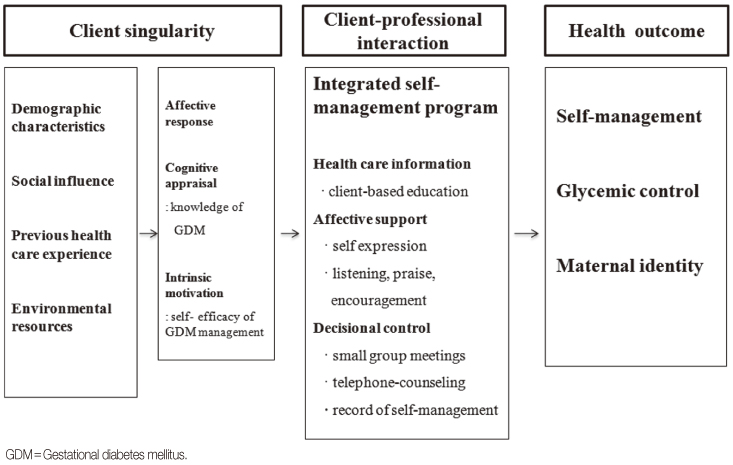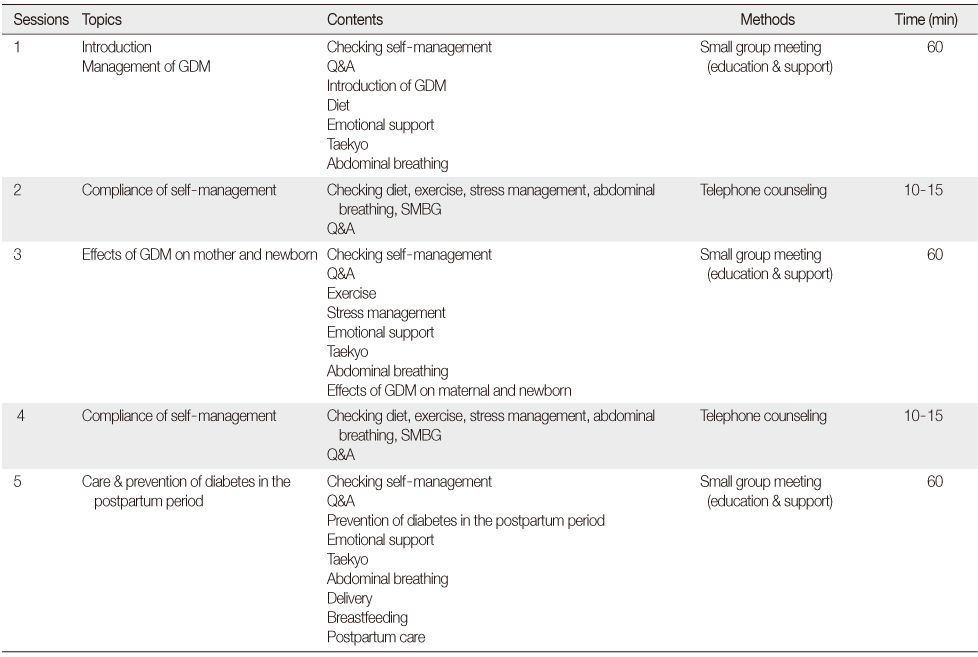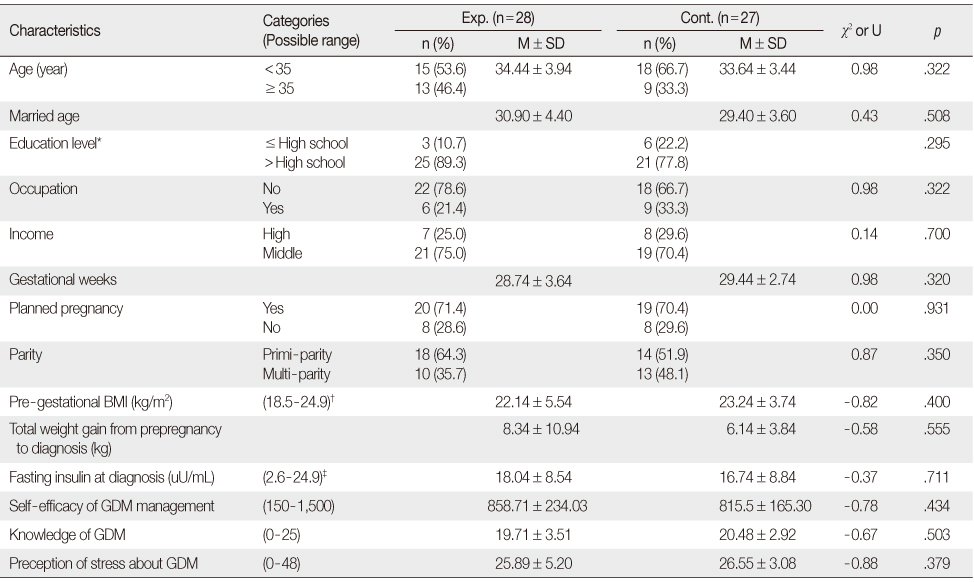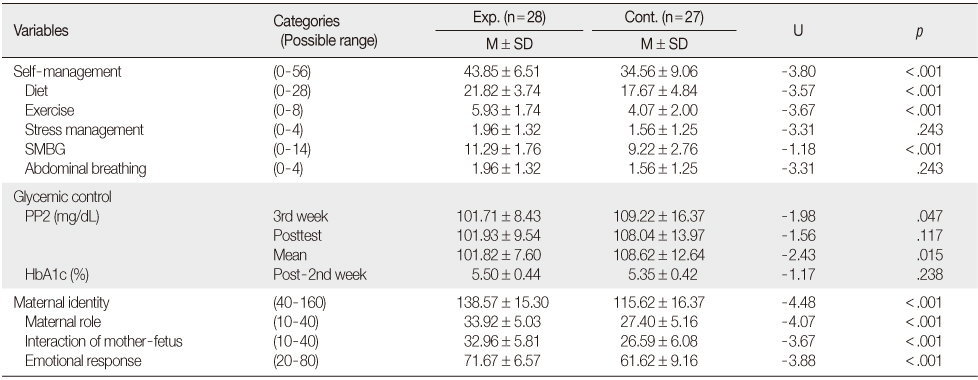Articles
- Page Path
- HOME > J Korean Acad Nurs > Volume 43(1); 2013 > Article
-
Original Article
- Effects of an Integrated Self-Management Program on Self-Management, Glycemic Control, and Maternal Identity in Women with Gestational Diabetes Mellitus
- HeeSook Kim, Sue Kim
-
Journal of Korean Academy of Nursing 2013;43(1):69-80.
DOI: https://doi.org/10.4040/jkan.2013.43.1.69
Published online: February 28, 2013
1Department of Nursing, Dongnam Health College, Suwon, Korea.
2College of Nursing · Nursing Policy Research Institute, Yonsei University, Seoul, Korea.
- Address reprint requests to: Kim, HeeSook. Department of Nursing, Dongnam Health College, 50 Cheoncheon-ro 74-gil, Jangan-gu, Suwon-si, Gyeonggi-do 440-714, Korea. Tel: +82-31-249-6657, Fax: +82-31-249-6480, khs0204@dongnam.ac.kr, kimhs02041@hotmail.com
© 2013 Korean Society of Nursing Science
Abstract
-
Purpose
- The purpose of the study was to investigate the effects of an integrated self-management program on self-management, glycemic control, and maternal identity in women with gestational diabetes mellitus (GDM).
-
Methods
- A non-equivalent control group non-synchronized quasi-experimental design was used. A total of 55 women with GDM were recruited from Cheil General Hospital, Seoul, Korea and were assigned to an experimental (n=28) or control group (n=27). The participants were 24-30 weeks pregnant women who had been diagnosed with GDM as of July 30, 2010. The program was conducted as a 1 hour small group meeting 3 out of 5 times and by telephone-counseling 2 out of 5 times. The integrated self-management program was verified by an expert panel.
-
Results
- Although there was no significant reduction in HbA1c (U= -1.17, p=.238), there were statistically significant increases in self-management (U= -3.80, p<.001) and maternal identity (U= -4.48, p<.001), and decreased 2-h postprandial glucose levels (U= -2.43, p<.015) in the experimental group compared to the control group.
-
Conclusion
- These findings suggest that an integrated self-management program for women with GDM improves self-management, maternal identity, and glycemic control. Further studies are needed to identify the effects of an integrated self-management program on pregnancy and neonatal outcomes.
This manuscript is a condensed form of the first author's doctoral dissertation from Yonsei University.
This study was supported by the Seoul Nurses Association fund in 2010.
- 1. American Diabetes Association. Gestational diabetes mellitus. Diabetes Care. 2003;26:Suppl 1. S103–S105.ArticlePubMedPDF
- 2. Bandura A. Social foundations of thought and action: A social cognitive theory. 1986;Englewood Cliffs, NJ, Prentice Hall.
- 3. Choi ES, Oh JA, Hur MH, Lee IS, Choi SY. The knowledge and learning needs about gestational diabetes in pregnant women. J Korean Acad Womens Health Nurs. 2000;6(1):96–108.ArticlePDF
- 4. Cox CL. An interaction model of client health behavior: Theoretical prescription for nursing. ANS Adv Nurs Sci. 1982;5(1):41–56.PubMed
- 5. Cox CL, Sullivan JA, Roghmann KJ. A conceptual explanation of risk-reduction behavior and intervention development. Nurs Res. 1984;33(3):168–173. http://dx.doi.org/10.1097/00006199-198405000-00010.PubMed
- 6. Cunningham FG, Leveno KJ, Bloom SL, Hauth JC, Rouse D, Spong CY. Williams obstetrics. 2010;New York, McGraw-Hill Professional.
- 7. Day JL. Diabetic patient education: Determinants of success. Diabetes Metab Res Rev. 2000;16:Suppl 1. S70–S74.ArticlePubMed
- 8. Faul F, Erdfelder E, Lang AG, Buchner A. G*Power 3: A flexible statistical power analysis program for the social, behavioral, and biomedical sciences. Behav Res Methods. 2007;39(2):175–191. http://dx.doi.org/10.3758/BF03193146.ArticlePubMedPDF
- 9. Gilbert ES. Manual of high risk pregnancy delivery. 2007;St. Louis, MO, Mosby.
- 10. Gu MO. Structural model for self care behavior and metabolic control in diabetic patient. 1992;Seoul, Seoul National University. Unpublished doctoral dissertation.
- 11. Han KJ. Development of the maternal-fetal interaction belief scale. J Korean Acad Child Health Nurs. 2007;13(3):265–272.
- 12. Hjelm K, Bard K, Nyberg P, Apelqvist J. Swedish and Middle-Eastern-born women's beliefs about gestational diabetes. Midwifery. 2005;21(1):44–60. http://dx.doi.org/10.1016/j.midw.2004.09.004.ArticlePubMed
- 13. Hjelm K, Berntorp K, Frid A, Aberg A, Apelqvist J. Beliefs about health and illness in women managed for gestational diabetes in two organisations. Midwifery. 2008;24(2):168–182. http://dx.doi.org/10.1016/j.midw.2006.12.008.ArticlePubMed
- 14. Jung JH. The effect of a telephone follow-up on self-efficacy and self-care in diabetes mellitus patients. 2002;Seoul, Ewha Womans University. Unpublished master's thesis.
- 15. Kim DJ. Epidemiology and current management status of diabetes mellitus in Korea. Paper presented at the meeting of the 2012 International Conference on Diabetes and Metabolism. 2012;11;Seoul, Korea.PubMed
- 16. Kim GS. AMOS 4: Analysis structural equation modeling. 2001;Seoul, SPSS Academy.
- 17. Kim HJ. The study of the maternal identity and fetal attachment behavior by pregnant women. Holy Spirit Jr Coll Nurs. 1997;7:83–96.
- 18. Kim HW. Model construction of maternal identity in primi-gravida. 1996;Seoul, Seoul National University. Unpublished doctoral dissertation.
- 19. Kim HW, Hong KJ. Development of a maternal identity scale for pregnant women. J Nurs Acad Soc. 1996;26(3):531–543.ArticlePDF
- 20. Kim JS. The effect of mother-fetus interaction promotion program of talking and tactual stimulation on mother-fetus interaction and mother-infant play interaction. Korean Parent Child Health J. 2002;5(2):253–276.
- 21. Kim OR. Effects of self care program on hypertensive control in hypertensive patient. J Korean Community Nurs. 2003;14(4):568–578.
- 22. Kim YO. A hypothesized model for self-care behavior in diabetic patients: Based on stress-coping model. 1996;Seoul, Yonsei University. Unpublished doctoral dissertation.
- 23. Lederman RP, Lederman E, Work BA Jr, McCann DS. Relationship of psychological factors in pregnancy to progress in labor. Nurs Res. 1979;28(2):94–97. http://dx.doi.org/10.1097/00006199-197903000-00012.PubMed
- 24. LeRoith D, Taylor SI, M OJ. Diabetes mellitus: A fundamental and clinical text. 2004;3rd ed. Philadelphia, Lippincott Williams & Wilkins.
- 25. Lewis SM, Heitkemper MM, Dirksen SR. Medical-surgical nursing: Assessment and management of clinical problems. 2004;6th ed. St. Louis, Mosby.
- 26. Manrique C, Bosler O, Becquet D, Héry F, Faudon M, François-Bellan AM. Post-lesion up-regulation of 5-HT1B binding sites in the suprachiasmatic nucleus may be reversed after spontaneous or graft-induced serotonin reinnervation. Brain Res. 1998;788(1-2):332–336. http://dx.doi.org/10.1016/S0006-8993(98)00043-2.ArticlePubMed
- 27. Mendelson SG, McNeese-Smith D, Koniak-Griffin D, Nyamathi A, Lu MC. A community-based parish nurse intervention program for Mexican American women with gestational diabetes. J Obstet Gynecol Neonatal Nurs. 2008;37:415–425. http://dx.doi.org/10.1111/j.1552-6909.2008.00262.x.ArticlePubMed
- 28. Mercer RT. The process of maternal role attainment over the first year. Nurs Res. 1985;34(4):198–204.PubMed
- 29. Polonsky WH, Earles J, Smith S, Pease DJ, Macmillan M, Christensen R, et al. Integrating medical management with diabetes self-management training: A randomized control trial of the diabetes outpatient intensive treatment program. Diabetes Care. 2003;26(11):3048–3053. http://dx.doi.org/10.2337/diacare.26.11.3048.PubMed
- 30. Radder JK, van Roosmalen J. HbA1c in healthy, pregnant women. Neth J Med. 2005;63(7):256–259.PubMed
- 31. Rasmussen KM, Yaktine AL. Weight gain during pregnancy: Reexamining the guidelines. 2009;Washington, DC, Institute of Medicine, National Research Council.
- 32. Reid T. Maternal identity in preterm birth. J Child Health Care. 2000;4(1):23–29. http://dx.doi.org/10.1177/136749350000400104.ArticlePubMedPDF
- 33. Rubin R. Maternal identity and the maternal experience. 1984;New York, Springer Pub. Co.
- 34. Rutter M. Clinical implications of attachment concepts: Retrospect and prospect. J Child Psychol Psychiatry. 1995;36(4):549–571.ArticlePubMed
- 35. Shin HJ, Park YJ, Kang HC. Prediction model on mother-infant attachment during the early postpartum period. J Korean Acad Nurs. 2004;34(3):504–514.ArticlePDF
- 36. Vamy T, Kelly J. The secret life of the unborn child. 1981;New York, Dell Publishing.
REFERENCES

C1, E1 (Pretest)=Self-management, Glycemic control (PP2, HbA1c), Maternal identity, general characteristics; C2, E2 (3rd week)=Glycemic control (PP2); C3, E3 (Posttest)=Self-management, Glycemic control (PP2), Maternal identity; C4, E4 (Post-2nd week)=Glycemic control (HbA1c); X=Integrated self-management program (total 5 times).
Figure & Data
REFERENCES
Citations

- Effect of Self Management to Quality of Life for Pregnant Woman with Gestational Diabetes Mellitus by Family Strength
Seo Jin Park
Journal of Health Informatics and Statistics.2023; 48(4): 398. CrossRef - Self-management and self-efficacy of women with gestational diabetes mellitus: a systematic review
Savvato Karavasileiadou, Wafa Almegewly, Anwar Alanazi, Hanan Alyami, Sofia Chatzimichailidou
Global Health Action.2022;[Epub] CrossRef - Why Is Blood Glucose Control Important to Self-Care of Pregnant Women with Gestational Diabetes Mellitus?
Mi-Joon Lee, Bum Jeun Seo, Yeon Sook Kim
Sustainability.2022; 14(16): 9946. CrossRef - Psychosocial support interventions for women with gestational diabetes mellitus: a systematic review
Seulgi Jung, Yoojin Kim, Jeongok Park, Miyoung Choi, Sue Kim
Korean Journal of Women Health Nursing.2021; 27(2): 75. CrossRef - The effect of self care counseling on health practices of 35 years or more aged pregnant women referring to Hamadan health care centers, in 2018
Soodabeh Aghababaei, Fereshteh Omidifard, Ghodratollah Roshanaei, Parisa Parsa
Avicenna Journal of Nursing and Midwifery Care.2020; 28(1): 67. CrossRef - Effects of stress, depression, and spousal and familial support on maternal identity in pregnant women
Hye-Jung Seo, Ju-Eun Song, Youngjin Lee, Jeong-Ah Ahn
Korean Journal of Women Health Nursing.2020; 26(1): 84. CrossRef - The effects of health care programs for gestational diabetes mellitus in South Korea: a systematic review
Seo Jin Park, Jina Lee
Korean Journal of Women Health Nursing.2020; 26(4): 274. CrossRef - Effects of a supportive program on uncertainty, anxiety, and maternal-fetal attachment in women with high-risk pregnancy
Hyun Jin Kim, Nami Chun
Korean Journal of Women Health Nursing.2020; 26(2): 180. CrossRef - Theoretical evaluation of Cox’s interaction model of client health behavior for health promotion in adult
women
Youlim Kim, Hyeonkyeong Lee, Gi Wook Ryu
Korean Journal of Women Health Nursing.2020; 26(2): 120. CrossRef - Relationship among Emotional Clarity, Maternal Identity, and Fetal Attachment in Pregnant Women with Gestational Diabetes Mellitus
Su Min Lee, Hye-Ja Park
Korean Journal of Women Health Nursing.2017; 23(2): 99. CrossRef - Evaluation of information retention and adherence to treatment in patients with gestational diabetes mellitus after multidisciplinary group
Ana Maria da Silva Sousa, Daine Fiuza, Fernanda Cristina Ferreira Mikami, Karen Cristine Abrão, Rossana Pulcineli Vieira Francisco, Marcelo Zugaib
Revista da Associação Médica Brasileira.2016; 62(3): 212. CrossRef - Analysis of Reported Study on Intervention Programs for Patients with Diabetes Mellitus
Gab-Sun Song, Ho-Jin Kim, Jum-Yi Jun
Journal of Digital Convergence.2015; 13(9): 541. CrossRef - Development and Application of a Self-management Program based on Prothrombin INR Monitoring for Patients with Cardiac Valve Replacement
Hyun Rye Jeon, Jeong Sook Park
Journal of Korean Academy of Nursing.2015; 45(4): 554. CrossRef - Development of Web-based u-Health Self-nutrition Management Program for Diabetic Patients
Yun Ahn, Jeahurn Bae, Hee-Seon Kim
Korean Journal of Community Nutrition.2014; 19(4): 372. CrossRef - The Design of the Self-diagnosis Algorithm for the Efficient Control of Sudden Cancer Pain
Eun-Young Jung, Sung-Jong Eun, Byoung-Hui Jeong, Yong-Joon Lee, Dong-Kyun Park
The Journal of the Korea Contents Association.2014; 14(5): 458. CrossRef - Effects of a Coaching Program on Comprehensive Lifestyle Modification for Women with Gestational Diabetes Mellitus
Jung Mi Ko, Jong Kyung Lee
Journal of Korean Academy of Nursing.2014; 44(6): 672. CrossRef - Effects of an Integrated Case Management Program on Medication Adherence, Pain, Physical Function and Depression among Korean Medical Aid Beneficiaries with Osteoarthritis
Yang Heui Ahn
Journal of Korean Public Health Nursing.2014; 28(1): 32. CrossRef - Role of Diabetes Educators and Effectiveness of Diabetes Education
HeeSook Kim
The Journal of Korean Diabetes.2013; 14(4): 194. CrossRef

Figure 1
Research Design
C1, E1 (Pretest)=Self-management, Glycemic control (PP2, HbA1c), Maternal identity, general characteristics; C2, E2 (3rd week)=Glycemic control (PP2); C3, E3 (Posttest)=Self-management, Glycemic control (PP2), Maternal identity; C4, E4 (Post-2nd week)=Glycemic control (HbA1c); X=Integrated self-management program (total 5 times).
Contents of the Integrated Self-Management Program
GDM=Gestational diabetes mellitus; SMBG=Self monitoring of blood glucose.
Homogeneity Test of Characteristics for the Experimental and Control Groups (N=55)
Exp.=Experimental group; Cont.=Control group; GDM=Gestational diabetes mellitus; BMI=Body mass index.
*Fisher's exact test; †2009 Institute of Medicine (IOM) criteria; ‡Normal range.
Homogeneity Test of Dependent Variables for the Experimental and Control Groups (N=55)
Exp.=Experimental group; Cont.=Control group; PP2=2-hour postprandial glucose; HbA1c=Hemoglobin A1c.
*Normal range.
Differences in Dependent Variables between the Experimental and Control Groups (N=55)
Exp.=Experimental group; Cont.=Control group; SMBG=Self-monitoring of blood glucose; PP2=2-hour postprandial glucose; HbA1c=Hemoglobin A1c.
C1, E1 (Pretest)=Self-management, Glycemic control (PP2, HbA1c), Maternal identity, general characteristics; C2, E2 (3rd week)=Glycemic control (PP2); C3, E3 (Posttest)=Self-management, Glycemic control (PP2), Maternal identity; C4, E4 (Post-2nd week)=Glycemic control (HbA1c); X=Integrated self-management program (total 5 times).
GDM=Gestational diabetes mellitus; SMBG=Self monitoring of blood glucose.
Exp.=Experimental group; Cont.=Control group; GDM=Gestational diabetes mellitus; BMI=Body mass index. *Fisher's exact test; †2009 Institute of Medicine (IOM) criteria; ‡Normal range.
Exp.=Experimental group; Cont.=Control group; PP2=2-hour postprandial glucose; HbA1c=Hemoglobin A1c. *Normal range.
Exp.=Experimental group; Cont.=Control group; SMBG=Self-monitoring of blood glucose; PP2=2-hour postprandial glucose; HbA1c=Hemoglobin A1c.
 KSNS
KSNS
 E-SUBMISSION
E-SUBMISSION





 Cite
Cite

